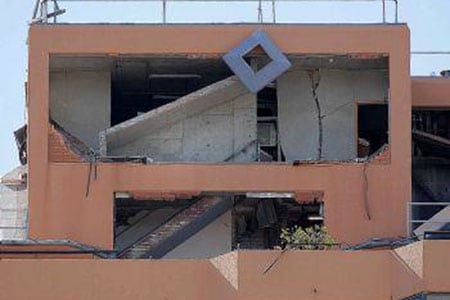
Gas Explosion Takes Out Lifts.
On 30 March 2009 a gas explosion occurred on level 29 in the plant room area of a residential high-rise building in Spring Street, Bondi Junction, where two plumbers were working on a gas-fired water heater.
There was no ongoing fire, but the blast wave travelled down a riser and blew in most of the doors on levels 23 and above, including the fire stair and lift doors, making the lifts inoperable.
Walls were blown out on the top two levels and there were cracks in the stairwell at level 26, which progressively worsened on higher levels.
The Residents
When the firefighters arrived, residents, having felt the blast and heard the fire alarms, were making their way down the fire stairs.
However, many were elderly and a significant number were either physically unable to use the stairs, or uncertain if they would be able to manage them. Four residents were in wheelchairs and three had walking frames.
Many were unwilling to leave their homes and worried about their possessions, phones and medications.
The Stairs
There were two sets of one-metre-wide fire stairs in the residential tower, one set exiting at street level, the other at level 9, on top of the shopping centre from where other stairs led to street level.
The level 9 exit door had partially collapsed from the blast, and there was the danger of more debris falling from the upper levels on to the roof of the shopping centre. Therefore, the set of stairs that led directly to street level was the main access used for both operations and evacuations.
Initial Operations
The NSW Fire Brigade was notified of the incident by the automatic fire alarm system at 12.41pm and the first fire appliance arrived at 12.46pm. By that time, many triple-zero calls had been received and the response had been upgraded to 3rd Alarm. This was upgraded to 4th Alarm by the first arriving senior officer.
Crews were informed by security guards that a large explosion had occurred on level 29 and there were casualties. Crews in breathing apparatus climbed the stairs to level 29. There was no fire, so they immediately began search and rescue operations on the damaged floors.
Search And Rescue
Levels 28 to 30 were declared the hot zone, and levels 26 and 27 the warm zone. A forward command post and staging area was established on level 26.
Search and rescue operations started on level 30 and worked down, assisted by the fact that many of the doors had been blown in from level 23 up -those that had not were forcibly opened.
The only casualties were the two plumbers, who had been severely burned in the explosion. They had made their way down the fire stairs unaided and, as soon as they were located, they were treated by paramedics and taken to hospital.
The whole building was evacuated because of structural damage, inoperable lifts and lack of utilities.
Download Free Personal Emergency Evacuation Plan PEEP Templates
Evacuation Operations
Residents who were unable to self-evacuate were assisted by firefighters with complete evacuation, taking about three hours to complete.
Wheelchairs
The four residents in wheelchairs were carried down the stairs in their wheelchairs. It took four firefighters to carry each wheelchair, and a backup crew was required so that crews could be rotated every few floors.
Carrying Residents Down Stairs
Stretchers could not be used due to the narrow stairs, so firefighters used chairs to carry some residents down the stairs. The Ambulance Service provided folding chairs which were very useful, and steel framed chairs from units were also used.
This could be undertaken with two firefighters, but the residents being evacuated felt safer with four.
Lighting
At one stage, electrical power to the building was disconnected as a safety precaution, meaning there was no light in the fire stairs. Firefighters then used torches but after about 30 minutes it was decided to resume power because it was too difficult to operate in the stairways without adequate light.
The Shopping Centre
The shopping centre at the base of the tower was also evacuated. The explosion had set off its fire alarms, so the evacuation was largely conducted by the centre’s security guards in accordance with its emergency plans and was completed early in the operation.
After Evacuation
Residents were evacuated to an assembly area where police took their details and paramedics assisted those who needed medical attention. Many elderly residents had not been able to bring their medications which became a source of considerable anxiety as regular medication times approached.
The police made arrangements for residents to go to the Leagues Club next door for refreshments, and NSWFB officers joined with police to provide briefings to the residents on the progress of the incident.
Unfortunately, the building was declared uninhabitable and residents were not able to return to their homes for some months until structural work on the building had been completed and lifts and utilities restored.
The District Emergency Management Officer (DEMO) was contacted and arrived in the early stages of the incident, taking responsibility for the logistics of finding alternative accommodation for the evacuees. Many residents were members of the Jewish community and the Jewish Emergency Response Plan was activated to assist with accommodation and support.
Crew Management
Crew Accountability
Crew accountability was a challenge due to the size of the building. The Incident Crew Management System (ICMS) board was set up at the entrance to the building, but it was challenging to keep track of the location of crews within the building due to difficulties with radio communications within the building and the crews splitting up to assist different residents or undertake other tasks, which ICMS was not equipped to handle.
Crew Welfare
In the initial stages of the incident firefighters used full structural firefighting uniform and breathing apparatus. When the risk level was reduced, a lower level of protective equipment could be used, but helmets were worn at all times.
Luckily the incident occurred on a mild day. If it had been hot, many more crew rotations would have been necessary.
There were several major incidents in Sydney that day, and some crews were reassigned to other incidents following allocation of a Code 4 to this incident.
Lessons Learned
- High-rise apartment buildings are likely to have a proportion of elderly residents who may be unable to manage stairs. If lifts are not working. Evacuating a high-rise residential building will require considerable additional resources.
- Carrying a person down stairs requIres at least two people. Wheelchairs require a least four, so that carriers can be rotated.
- The ambulance service has folding cars hat can be used for carrying people downstairs. Ordinary steel frame chairs can also be used.
- If possible, allow people to get their medications, wallets and mobile phone before evacuation.
- Whenever possible, maintain lighting to the fire stairs. If the power has to be cut, an adequate alternative lighting source will be required.
- If two sets of stairs are available consider using one for operations a one for evacuations.
- Crew management is an issue. Make sure sufficient resources are allocated to ICMS functions.
- Set up an evacuee assembly area as soon as possible to ensure the names and unit numbers of evacuees and identify those who are missing
- Call the District Emergency Management Officer (DEMO) as soo as possible to assist With logistiCS and recovery operations.
- Call for engineers as soon as possible to assess the structural integrity of the building. Engineers may be sourced from the local council or through the DEMO.
- Consider whether crews leaving a major inCident should be immediately available for reassignment or should be given time to recuperate.
___________________________________
What Concerns Me Most Are The Comments
The four residents in wheelchairs were carried down the stairs in their wheelchairs. It took four firefighters to carry each wheelchair, and a backup crew was required so that crews could be rotated every few floors.
Residents who were unable to self-evacuate were assisted by firefighters with complete evacuation, taking about three hours to complete.
How Could This Be Improved
There are two scenarios I can see that could improve firefighters resources and the speed of evacuation.
Scenario 1
All building to be fitted with approved evacuation chairs at all levels that emergency services could easily access to evacuate residents. Instead of the ratio of 4 firefighters per person a ratio of one to one would suffice freeing up resources.
The minimal cost of chairs when applied to an overall developmet cost (Chair cost $2,000-$4000) could easily be justified or even mandated on developments.
This could also be easly implimented to existing building at the time of the renewal of evacuation plans and policies.
Scenario 2
As with the abulances all fire firghting appliance to be fitted with a minimum of two evacuation chairs. Chairs are of a light weight depending on brand 10-15KG and easy to carry up multiple flights of stairs. Minimal training is required due to the simplicity of design.
___________________________________
Update 24 October 09
Evacuation Chairs for Disabled (H 3724)
The Committee on Public Safety and Homeland Security held a hearing on legislation requiring all residential buildings over four stories high to be equipped with evacuation chairs on each stairwell or evacuation route.
The measure is sponsored by the Massachusetts Disability Policy Consortium and is aimed at helping with the emergency evacuation of people with disabilities who live on floors that are higher than fire department ladders.

